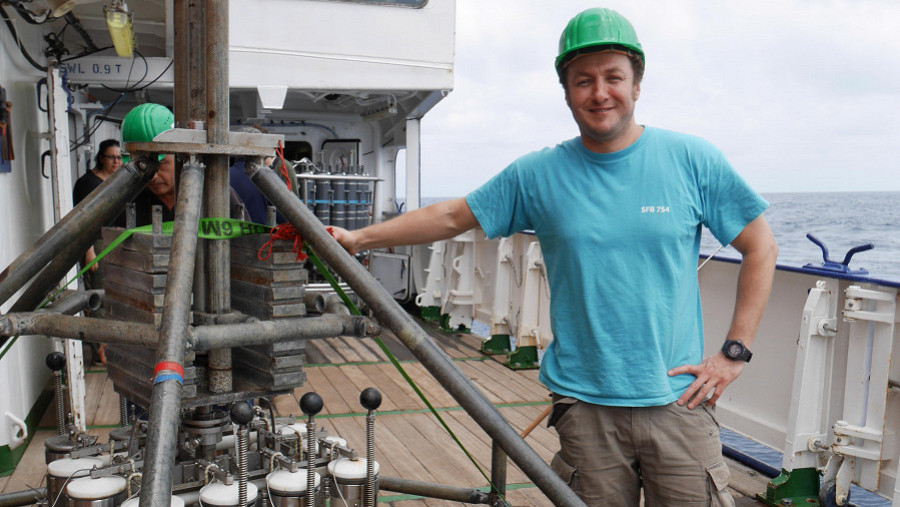Species shift due to tipping point in Humboldt Current off Peru.

Fundamental changes in the ocean such as increasing warming, acidification or oxygen reduction can have significant consequences for the composition of fish stocks - even displacing individual species. Researchers at Kiel University (CAU), together with colleagues from Germany, Canada, the USA and France, have reconstructed environmental conditions of the older warm period 125,000 years ago (Eemian- Interglacial) using sediment samples from the Humboldt Current area off Peru. They were able to show that at warmer temperatures mainly smaller, goby-like fish species became established and pushed back important food fish such as the anchovy (Engraulis ringens). The trend is independent of fishing pressure and fisheries management. According to the study, the increased warming of the Humboldt Current region as a result of climate change has more far-reaching implications for the ecosystem and the global fishing industry than previously thought. The findings appeared Jan. 7th in the journal Science.
The sea off the west coast of South America is now one of the most vital and productive fishing grounds on earth. About eight percent of the global marine catch comes from the areas off the coasts of Peru, where the near-surface Humboldt Current provides a high nutrient supply and thus sufficient food for commercially exploited fish species such as the anchovy. Ten percent of the total global catch of anchovy alone comes from the region. Much of it is processed into fish meal and oil and fed primarily to aquacultures in China and Norway. However, catches of anchovy in the Humboldt upwelling system are currently declining significantly, while smaller schooling fish such as goby are increasing. The reasons for the shift in species are still unclear and are the subject of the current study.
Researchers from the Institute of Geosciences at Kiel University, together with colleagues from GEOMAR Helmholtz Centre for Ocean Research and international partners, have for the first time investigated the relationships between temperature, oxygen content, nutrient supply and the occurrence of individual fish species using paleo-oceanographic data from the Humboldt Current area. The scientists focused on the older warm period about 125,000 years ago (Eemian interglacial). During this time, conditions were similar to those predicted by climate projections (e.g., the IPCC report) for the end of the 21st century at the latest: i.e., comparable primary production, but water temperatures two degrees Celsius higher than today and increased oxygen deficiency in intermediate water depths.
For their paleo-oceanographic studies, the scientists at Kiel University primarily analyzed small fish eddies that they were able to isolate from sediment cores. According to the results, smaller, goby-like fish predominated in coastal waters during the older warm period, while anchovies made up only a small proportion. Fish with smaller body sizes can adapt better to warmer temperatures. They maintain their high activity levels even in less oxygenated waters thanks to their larger gill surface area relative to their body volume.
"The conditions of this past warm period, which we were able to reconstruct from our samples, can definitely be compared to the current development and put in context with future scenarios," says first author of the study, Dr. Renato Salvatteci, who is currently conducting research at the Center for Ocean and Society of the Kiel Marine Science (KMS) research center at Kiel University in the BMBF-funded Humboldt-Tipping project. "According to this, there is a clear regime shift toward smaller fish that are more comfortable in the warm, lower-oxygen conditions. We conclude from our results that the effects of human-induced climate change may have a stronger influence on the evolution of stocks in the region than previously thought," Salvatteci added. Smaller fish are harder to catch and less palatable. According to the report, the impact on the Peru region, local fisheries income and global trade in anchovies could be far-reaching - potentially affecting global food security.
"Our studies based on the sediment cores can give us fairly accurate information about the changes and their dynamics in highly productive coastal waters worldwide that have occurred in the wake of different climate states and over different time scales," explains Professor Ralph Schneider, a paleoclimate researcher at the Institute of Geosciences at Kiel University and co-author of the study.
Due to increasing warming in the Humboldt Current upwelling region, the researchers believe the ecosystem is heading toward a tipping point, beyond which anchovy will begin to retreat and no longer dominate nearshore fishing grounds. "Despite a flexible, sustainable and adaptive management strategy, anchovy biomass and landings have declined, suggesting that we are closer to the ecological tipping point than suspected," summarizes lead author Renato Salvatteci. The results help to better assess the extent to which a warming ocean can provide sufficient food for the world's population and what changes humanity should expect for the development of important fish species such as the anchovy.
The study was funded by the Collaborative Research Center (SFB) 754 "Climate-Biogeochemical Interactions in the Tropical Ocean," a cooperative project of Kiel Christian Albrechts University (CAU) and GEOMAR Helmholtz Centre for Ocean Research Kiel. Additional support came from the BMBF project Humboldt-Tipping, coordinated at the Center for Ocean and Society, as well as funding from the Emmy-Noether Junior Research Group ICONOX at GEOMAR. First author Renato Salvatteci was also supported by a fellowship from the Alexander von Humboldt Foundation.
Original publication:
Renato Salvatteci, Ralph R. Schneider, Eric Galbraith, David Field, Thomas Blanz, Thorsten Bauersachs, Xavier Crosta, Philippe Martinez, Vincent Echevin, Florian Scholz, Arnaud Bertrand, "Smaller fish species in a warm and oxygen-poor Humboldt Current System".
https://doi.org/10.1126/science.abj0270
Links
https://humboldt-tipping.org/en
https://www.geomar.de/forschen/fb2/fb2-mg/iconox
https://oceanandsociety.org/de/teammitglieder/dr-renato-salvatteci


